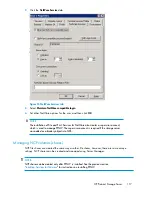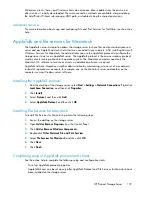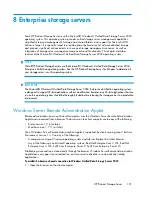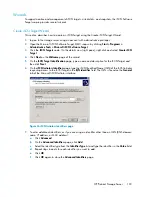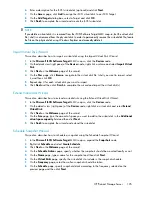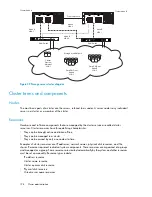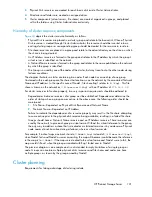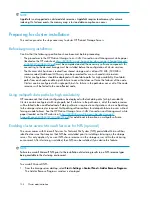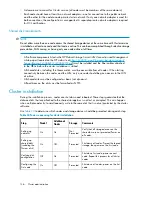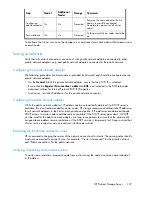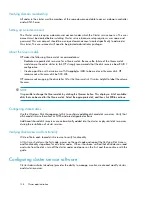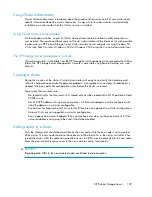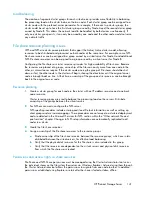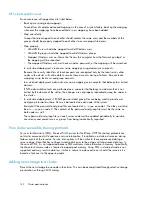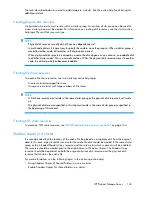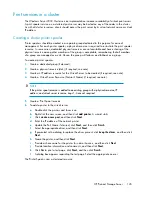
3.
Physical Disk resources are created for each basic disk inside Cluster Administrator.
4.
Directories and folders are created on assigned drives.
5.
Cluster components (virtual servers, file shares) are created, organized in groups, and placed
within the folders using Cluster Administrator exclusively.
Hierarchy of cluster resource components
Figure 40
depicts the cluster resource hierarchy as follows:
•
Physical Disk resources are placed in a cluster group and relate to the basic disk. When a Physical
Disk resource is created through Cluster Administrator, the resource should be inserted into an
existing cluster group or a corresponding group should be created for the resource to reside in.
•
File share resources are placed in a group and relate to the actual directory on the drive on which
the share is being created.
•
An IP Address resource is formed in the group and relates to the IP address by which the group's
virtual server is identified on the network.
•
A Network Name resource is formed in the group and relates to the name published on the network
by which the group is identified.
•
The Group is owned by one of the nodes of the cluster, but may transition to the other nodes during
failover conditions.
The diagram illustrates a cluster containing two nodes. Each node has ownership of one group.
Contained within each group are file shares that are known on the network by the associated Network
Name and IP address. In the specific case of Node1, file share Eng1 relates to
E:\Eng1
. This file
share is known on the network as
\\Fileserver1\Eng1
with an IP address of
172.18.1.99
.
For cluster resources to function properly, two very important requirements should be adhered to:
•
Dependencies between resources of a group must be established. Dependencies determine the
order of startup when a group comes online. In the above case, the following order should be
maintained:
1.
File Share—Dependent on Physical Disk Resource and Network Name
2.
Network Name—Dependent on IP Address
Failure to indicate the dependencies of a resource properly may result in the file share attempting
to come online prior to the physical disk resource being available, resulting in a failed file share.
•
Groups should have a Network Name resource and an IP Address resource. These resources are
used by the network to give each group a virtual name. Without this virtual reference to the group,
the only way to address a share that is created as a clustered resource is by node name. Physical
node names do not transition during a failover, whereas virtual names do.
For example, if a client maps a network share to
\\Node1\Eng1
instead of
\\Fileserver1\Eng1
,
when Node1 fails and Node2 assumes ownership, the map will become invalid because the reference
in the map is to
\\Node1
. If the map were created to the virtual name and Node1 were to fail, the
map would still exist when the group associated with Eng1 failed over to Node2.
The previous diagram is an example and is not intended to imply limitations of a single group or
node. Groups can contain multiple physical disks resources and file shares and nodes can have
multiple groups, as shown by the group owned by Node2.
Cluster planning
Requirements for taking advantage of clustering include:
HP ProLiant Storage Server
131
Содержание PROLIANT DL160 G5
Страница 1: ...HP ProLiant Storage Server user guide Part number 440584 005 First edition June 2008 ...
Страница 34: ...Installing and configuring the server 34 ...
Страница 52: ...Server components 52 ...
Страница 94: ...File server management 94 ...
Страница 112: ...Microsoft Services for Network File System MSNFS 112 ...
Страница 152: ...Troubleshooting servicing and maintenance 152 ...
Страница 154: ...System recovery 154 ...
Страница 160: ...BSMI notice Japanese notice Korean notice A B Class A equipment Class B equipment Regulatory compliance and safety 160 ...
Страница 174: ...Index 174 ...

